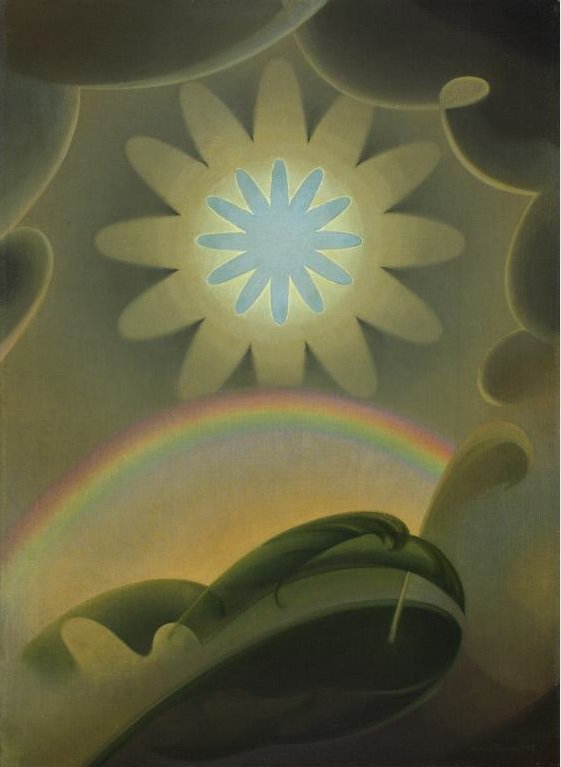In honor of Women’s History Month, we will be highlighting a female artist from Crystal Bridges’ art and library collections each Wednesday. We begin with this profile of Agnes Pelton by Interpretation Manager Stace Treat. –LD

Agnes Pelton photographed in 1932 in Cathedral City, CA. Mount San Jacinto is in the background. Photo courtesy of University of New Mexico Art Museum, Albuquerque.
Chances are, many folks familiar with American art and artists have probably never heard of Agnes Pelton. Most people, however, know of her contemporary, Georgia O’Keeffe. The parallels between both women’s lives are quite fascinating. Born five years apart, both Pelton and O’Keeffe studied painting with Arthur Wesley Dow at the Pratt Institute in Brooklyn, New York. They both participated in the first wave of modern art in New York during the 1910s, and both painted in comparable styles that abstracted from nature. Both were first introduced to the New Mexico desert by Mabel Dodge Luban, with Pelton’s first visit in 1919 beating O’Keeffe’s by a decade. But there, the two women’s stories diverge. O’Keeffe became a beloved national icon, while Pelton slipped into obscurity. So who is this enigmatic woman who painted the beautiful and mysterious work, Sand Storm (1932) in Crystal Bridges permanent collection?
Agnes Pelton (1881-1961) was born to American parents in Stuttgart, Germany. After her father died in 1890, she and her mother moved to Brooklyn, New York, where her mother taught piano lessons, as well as German and French. Young Agnes learned piano from her mother, and at age 14 began taking art classes at Pratt Institute. After graduating at age 19, she continued studying with two of her instructors, Arthur Wesley Dow and Hamilton Easter Field. She studied landscape painting with Dow, who emphasized structure, spirit, imagination, creation, and the non-naturalistic use of color, a technique he taught using Japanese prints to demonstrate space relations and the appropriate use of light and dark masses. Dow believed that the Japanese and the Chinese had already found the essence of the painting ideals that Modernism was still striving to achieve. Dow’s influence was critical to Pelton’s development of abstractions based on interior, spiritual values.
Pelton traveled to Italy for a year in 1910, where Field, also an enthusiast of oriental art, was residing. Under his guidance she studied Italian painters and did daily life drawing at the British Academy in Rome. Liberated by her studies, in 1911 she began what she called “Imaginative Paintings,” which were influenced by outdoor explorations of the effects of natural light, and continued through 1917. At a 1912 exhibition of Pelton’s recent paintings at Field’s studio in Ogunquit, Maine, Walt Kuhn was introduced to her work. Kuhn, the organizer of the Armory Show of 1913, invited her to exhibit two of her “Imaginative Paintings” in that landmark exhibition: Vine Wood and Stone Age.
Pelton made New York City her home Until 1921, but her need for solitude finally prompted her to find a rural environment, and she moved to Long Island. It was here in the winter of 1926 that she created her first original abstractions. She also began, during this time, to use notebooks to record her most personal thoughts on life and spiritual issues. From 1921 to 1932 Pelton traveled to Hawaii, New Hampshire, Beirut, Syria, Georgia, and Pasadena, finally relocating in Cathedral City outside of Palm Springs, California, where she remained for the rest of her life.
In the mid-1930s, Pelton became a founding member of a group of artists based in Taos, New Mexico, known as the Transcendental Painting Group (TPG). The TPG manifesto stated that their purpose was “to carry painting beyond the appearance of the physical world, through new concepts of space, color, light and design, to imaginative realms that are idealistic and spiritual.” The manifesto included the statement that “the work does not concern itself with political, economic, or other social problems.” Arranging exhibitions of transcendental work that would “serve to widen the horizon of art” became the focus of the TPG’s activity. Our painting Sand Storm (1932) represents one of Pelton’s contributions in this vein.
Pelton was also deeply influenced by literature, and especially the Romantic poetry of Keats, Shelley, and Wordsworth. Many of her paintings, in fact, have an accompanying poem that Pelton wrote herself, revealing elements of her inspiration for the images. She also read the esoteric and spiritualist writings of Madame Blavatsky on Theosophy and Occultism. A deeply spiritual person, Pelton’s life revolved around William Blake’s belief that “the Imagination is not a State: it is Human Existence itself.” As a person, Pelton was small, quiet, and described as “someone special” and having a “beautiful soul.” She believed that despite its many conflicts, the world was a place of kindness and grace.
So why is she so relatively unknown? Her gentle demeanor and relatively passive lifestyle most likely contributed to her slide into obscurity, as she did not have the strong force of presence to take charge of her career the way Georgia O’Keeffe did (nor, for that matter, a strong male promoter like Alfred Stieglitz in her corner). After a traveling exhibition of her work debuted in 1995, organized by the Palm Springs Desert Museum, interest in Agnes Pelton came alive once more, yet she continues to be an elusive and enigmatic figure in the history of American art.
Sand Storm is currently on view in Crystal Bridges’ Early Twentieth-Century Art Gallery.
SAND STORM By Agnes Pelton Dense clouds that push and loom Too early, darkening the day. Above the streaming palms Bent low to earth Sharp points of blowing sand converge Are poised beneath the sky’s light blue In balanced conformation. Below this flowering, remote, serene Behold the movement luminous – A rainbow in the dust.
Reference Agnes Pelton: Poet of Nature, Palm Springs Desert Museum, Michael Zakian, Associate Curator of Art, 1995. This book available in the Crystal Bridges Library.





